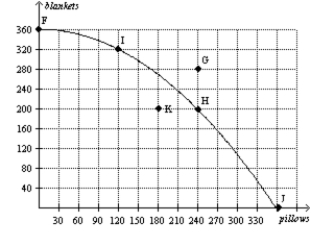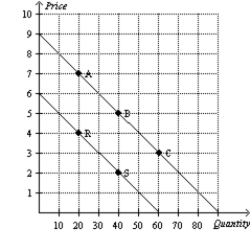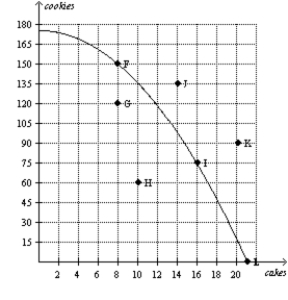A) upward sloping, and we say the variables are positively related.
B) upward sloping, and we say the variables are negatively related.
C) downward sloping, and we say the variables are positively related.
D) downward sloping, and we say the variables are negatively related.
Correct Answer

verified
Correct Answer
verified
Multiple Choice
Table 2-4
Production Possibilities for Picnicland
 -Refer to Table 2-4. What is the opportunity cost to Picnicland of increasing the production of burgers from 450 to 750?
-Refer to Table 2-4. What is the opportunity cost to Picnicland of increasing the production of burgers from 450 to 750?
A) 150 hotdogs
B) 225 hotdogs
C) 300 hotdogs
D) 450 hotdogs
Correct Answer

verified
Correct Answer
verified
Multiple Choice
Which of the following statements is correct?
A) Economists almost always find it easy to conduct experiments in order to test their theories.
B) Economics is not a true science because economists are not usually allowed to conduct experiments to test their theories.
C) Economics is a social science rather than a true science because it cannot employ the scientific method.
D) Economists are usually not able to conduct experiments, so they must rely on natural experiments offered by history.
Correct Answer

verified
Correct Answer
verified
Multiple Choice
The x-coordinate of an ordered pair specifies the
A) diagonal location of the point.
B) vertical location of the point.
C) horizontal location of the point.
D) quadrant location in which the point is located.
Correct Answer

verified
Correct Answer
verified
Multiple Choice
The scientific method is
A) the use of modern technology to understand the way the world works.
B) the use of controlled laboratory experiments to understand the way the world works.
C) the dispassionate development and testing of theories about how the world works.
D) the search for evidence to support preconceived theories about how the world works.
Correct Answer

verified
Correct Answer
verified
True/False
Economists at the U.S. Department of Justice help enforce the nation's antitrust laws.
Correct Answer

verified
Correct Answer
verified
Multiple Choice
When two variables have a negative correlation,
A) when the x-variable decreases, the y-variable decreases.
B) when the x-variable decreases, the y-variable increases.
C) when the x-variable increases, the y-variable increases.
D) More than one of the above is correct.
Correct Answer

verified
Correct Answer
verified
Short Answer
Suppose a war in the Middle East interrupts the flow of crude oil and oil prices skyrocket around the world. For economists, this historical episode serves as a
Correct Answer

verified
Correct Answer
verified
Multiple Choice
The use of the coordinate system allows
A) for the display of the flows of dollars, goods and services, and factors of production in an economic system.
B) for the display of how labor and other resources are organized in the production process.
C) for the display of two variables on a single graph.
D) for the creation of pie charts and bar graphs.
Correct Answer

verified
Correct Answer
verified
Multiple Choice
Figure 2-6  -Refer to Figure 2-6. The opportunity cost of this economy moving from point K to point H is
-Refer to Figure 2-6. The opportunity cost of this economy moving from point K to point H is
A) zero.
B) 50 blankets.
C) 60 pillows.
D) 50 blankets and 60 pillows.
Correct Answer

verified
Correct Answer
verified
Multiple Choice
In the markets for goods and services in the circular-flow diagram,
A) households and firms are both buyers.
B) households and firms are both sellers.
C) households are buyers and firms are sellers.
D) households are sellers and firms are buyers.
Correct Answer

verified
Correct Answer
verified
Short Answer
Figure 2-22  -Refer to Figure 2-22. What is the slope of the line with points A, B, and C?
-Refer to Figure 2-22. What is the slope of the line with points A, B, and C?
Correct Answer

verified
Correct Answer
verified
True/False
Normative statements describe how the world is, while positive statements prescribe how the world should be.
Correct Answer

verified
Correct Answer
verified
Multiple Choice
In building economic models, economists often omit
A) assumptions.
B) theories.
C) details.
D) equations.
Correct Answer

verified
Correct Answer
verified
Multiple Choice
When a production possibilities frontier is bowed outward, the opportunity cost of producing an additional unit of a good
A) increases as more of the good is produced.
B) decreases as more of the good is produced.
C) does not change as more of the good is produced.
D) may increase, decrease, or not change as more of the good is produced.
Correct Answer

verified
Correct Answer
verified
Multiple Choice
Unemployment would cause an economy to
A) produce inside its production possibilities frontier.
B) produce on its production possibilities frontier.
C) produce outside its production possibilities frontier.
D) experience an inward shift of its production possibilities frontier.
Correct Answer

verified
Correct Answer
verified
Short Answer
What you must give up to get something else is called the
Correct Answer

verified
Correct Answer
verified
True/False
Different values are not a reason for disagreement among economists.
Correct Answer

verified
Correct Answer
verified
True/False
If a line passes through the points (20,5) and (10,10), then the slope of the line is -2.
Correct Answer

verified
Correct Answer
verified
Multiple Choice
Figure 2-13  -Refer to Figure 2-13. Which of the following statements is true about point G for this economy?
-Refer to Figure 2-13. Which of the following statements is true about point G for this economy?
A) Point G is currently unattainable.
B) Point G is efficient.
C) At point G, more cakes are produced than cookies.
D) There is unemployment at point G.
Correct Answer

verified
Correct Answer
verified
Showing 121 - 140 of 617
Related Exams